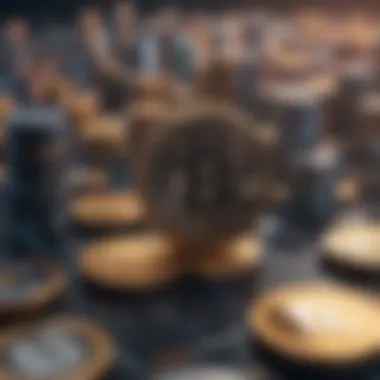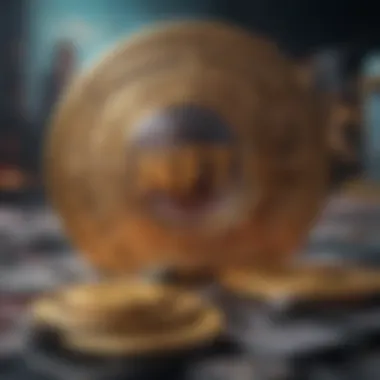Crafting Your Own NFT Token: A Comprehensive Guide


Intro
In recent years, the digital landscape has evolved dramatically, giving birth to unique asset classes known as non-fungible tokens (NFTs). The world of NFTs is intriguing yet often perplexing, especially for those stepping into this realm for the first time. With art, music, and even virtual real estate being sold as tokens on the blockchain, the question arises: how can one create their own NFT token?
Crafting an NFT isn't merely about minting a digital collectible; it’s about grasping the underlying technology and understanding the broader implications of digital ownership. This guide aims to illuminate the pathway to developing your own NFT, covering everything from essential concepts in cryptocurrency to practical steps in the creation process.
Your journey into the NFT world starts here, unraveling the complexities involved and equipping you with the knowledge you need to make informed decisions.
Understanding Cryptocurrency Basics
As we dive into the intricacies of NFT creation, it's important to first lay the groundwork by comprehending the core principles of cryptocurrency.
What is Cryptocurrency?
Cryptocurrency is a form of digital or virtual currency that utilizes cryptography for secure financial transactions. Unlike traditional currencies, cryptocurrencies operate on decentralized networks, predominantly using blockchain technology. This decentralized nature provides users with a certain level of anonymity and security, while also eliminating reliance on central banks or governments.
Digital currencies such as Bitcoin, Ethereum, and others have revolutionized how we perceive and interact with money. They offer a means to transfer value across borders without the typical layers of bureaucracy. In this context, NFTs emerge as unique tokens that represent ownership of a specific item, making them distinct from currencies meant for trading.
How Does Blockchain Technology Work?
To understand NFTs, one must first grasp blockchain technology. Think of the blockchain as a public ledger. This ledger records every transaction that takes place within a given cryptocurrency network. Each transaction is grouped into blocks, and these blocks are chained together in chronological order—a process that ensures transparency and security.
Here’s a concise breakdown of how blockchain works:
- Decentralization: There's no single point of control. Copies of the ledger exist across a multitude of nodes.
- Immutability: Once a block is added to the chain, it cannot be altered without consensus from the network.
- Transparency: While transactions are secure and pseudonymous, they are public and can be viewed by anyone.
This foundational technology allows NFTs to exist on the blockchain, enabling unique ownership and provenance tracking. Each NFT is attached to a specific smart contract, defining its characteristics and confirming its authenticity.
Overall, understanding these cryptocurrency basics gives you a solid footing as you embark on your NFT creation journey, enabling you to navigate the complexities ahead with confidence.
"Blockchain technology does not only represent an advancement in how we transact, but it redefines trust in digital environments."
As we forge ahead in this guide, it’s essential to take in these foundational ideas, as they are directly relevant to the creation and implementation of your NFT. However, there's much more to discover beyond just currency and technology; let's delve deeper into the investment strategies associated with NFTs next.
Intro to NFTs
The surge of interest surrounding non-fungible tokens (NFTs) has transformed the digital landscape, turning what seemed like a niche curiosity into a potent player in the economy of digital assets. This section serves as a foundational point for the unfolding discussion on NFTs. Understanding the essentials sets the stage for not just understanding what these digital goods can represent, but also how they can unlock new opportunities for artists, developers, and investors. In essence, NFTs are reimagining ownership in the digital realm.
Defining Non-Fungible Tokens
At its core, a non-fungible token (NFT) is a type of digital asset representing ownership of a unique item or piece of content, verified through blockchain technology. Unlike cryptocurrencies such as Bitcoin or Ethereum, which are fungible and can be exchanged on a one-to-one basis, NFTs carry distinct information or attributes that differentiate them from one another. This uniqueness is key. For example, owning an original NFT of a digital artwork implies ownership of that specific piece and not just a copy of it. This ownership is recorded immutably on the blockchain, making verification straightforward and reducing the chances of fraud.
People might ask, "What makes NFTs special?" Well, consider a signed painting; the signature adds value and rarity. Similarly, the data tied to an NFT dictates its worth and place in the market. Hence, art, music, videos, and even virtual real estate can become NFTs, opening a whole new playing field for creators and collectors alike.
The Rise of NFT Popularity
NFTs have climbed the popularity ladder faster than many might have anticipated. Various factors contribute to this meteoric rise. The creative community has, for a long time, yearned for better methods to prove ownership and authenticity in an era where digital duplication is rampant. Artists have started exploring NFTs as a means to monetize their work without relying solely on traditional galleries or auction houses.
Moreover, the initial sale figures in prominent NFT marketplaces got tongues wagging. Works from artists like Beeple made headlines by selling for tens of millions of dollars. This has generated a buzz, drawing spotlight onto the NFT space as not just a trend, but a viable investment opportunity.
However, the increasing mainstream attention has also sparked a parallel conversation around the sustainability and ethics of NFTs. From concerns about the environmental impact of blockchain transactions to the legal ramifications surrounding ownership rights, the discussion is as layered as it is lively.
In summary, the importance of understanding NFTs cannot be overstated. Being well-versed in their nature, evolution, and ongoing implications lays the groundwork for anyone interested in navigating the complicated waters of NFT creation and investment.
Understanding Blockchain Technology
Blockchain technology serves as the backbone of non-fungible tokens (NFTs) and understanding its intricacies is crucial for anyone aspiring to create their own NFT. To make sense of this digital asset phenomenon, you need to grasp how blockchain operates and why it is indispensable in this space. The benefits it offers are numerous, from enhancing security to ensuring transparency in transactions.
Blockchain Basics
At its core, a blockchain is a decentralized digital ledger that records transactions across multiple computers. This means that no single entity holds control over it; rather, it's maintained by a network of nodes. Each block in the chain contains a list of recent transactions, which are linked together cryptographically, ensuring that once information is entered, it cannot easily be altered. Each block references the previous one, forming a secure chain that’s incredibly resilient to tampering.
This decentralized nature has a couple key advantages:
- Security: The consensus mechanism used in blockchains, like Proof of Work or Proof of Stake, makes it extremely difficult for any malicious actor to alter the data.
- Transparency: Every participant in the network has access to the same information, thus promoting trust and accountability.
One could say a blockchain is like a public library; everyone can see the information, but only the librarian (the nodes) can update the records. This technology underpins cryptocurrencies like Bitcoin and Ethereum, with Ethereum being particularly notable for its capacity to support smart contracts, a necessity for NFT creation.
How Blockchain Facilitates NFTs
Blockchain is integral in facilitating NFTs for several reasons. Firstly, non-fungibility signifies that each token is unique and cannot be exchanged on a one-to-one basis like dollars or other fungible assets. This uniqueness is recorded on the blockchain, ensuring authenticity and ownership.


- Ownership Proof: The blockchain acts as a public record; anyone can check who owns what NFT at any given time. This eliminates the possibility of fraud and empowers creators.
- Smart Contracts: These are self-executing contracts with the terms of the agreement directly written into code. For NFTs, smart contracts automate processes such as transfer of ownership, payments to creators, or even royalty distribution whenever the NFT is sold in the future.
A particularly compelling example of NFTs that showcases how blockchain ensures their value and uniqueness are digital art pieces sold by artists. When you buy a digital painting as an NFT, the blockchain confirms your ownership and enables you to prove that you own the original piece, even if copies exist. This concept of originality in the digital age is vital for artists, helping them monetize their work in ways that traditional art markets couldn't facilitate.
"Blockchain technology is not just a trend; it is transforming how we perceive ownership, especially in the art world and beyond."
Choosing the Right Blockchain for Your NFT
Selecting a suitable blockchain is a pivotal step in crafting your non-fungible token (NFT). The blockchain you choose not only affects how your NFT functions but also its marketability, security, and scalability. Understanding the nuances of different blockchains will help you make an informed decision that aligns with your project's goals.
Comparing Major Blockchains
When delving into the world of NFTs, you’ll encounter a few heavy hitters in the blockchain space, each offering unique features. Here are some of the most prevalent options:
- Ethereum: Often seen as the go-to platform for NFT creation, it supports the ERC-721 token standard, enabling a robust NFT ecosystem. Its sizeable user base and well-established marketplaces like OpenSea and Rarible make it an attractive choice.
- Binance Smart Chain: Gaining traction for its lower fees and faster transactions compared to Ethereum, Binance Smart Chain supports NFTs through the BEP-721 standard. However, it is seen as somewhat less decentralized by some in the crypto community.
- Polygon: A layer 2 scaling solution for Ethereum, Polygon offers the benefits of Ethereum’s security while significantly reducing transaction costs. This makes it a popular choice for artists and developers looking to avoid high gas fees.
- Tezos: Not as widely recognized, but Tezos boasts a more energy-efficient protocol and lower costs. It has a smaller, yet dedicated, community of NFT enthusiasts and marketplaces like Hic et Nunc.
Each blockchain has its advantages and drawbacks; it’s crucial to weigh those factors against your project needs.
Factors Influencing Your Choice
The decision on which blockchain to use is influenced by several key considerations:
- Transaction Fees: This can have a substantial impact on profitability. Ethereum’s gas fees can spike during high traffic times, whereas Binance Smart Chain or Polygon may offer more predictable costs.
- Market Reach: The size and engagement of the user base on a particular blockchain can help determine your NFT's visibility. Ethereum has a well-established environment, while newer platforms might have growing yet smaller communities.
- Scalability: Think about whether the blockchain can handle increased usage. High transaction volumes can slow down networks, causing frustration among users.
- Environmental Impact: With rising concerns over the energy consumption of blockchain technology, you might prioritize networks with eco-friendlier protocols.
- Security: Choose a blockchain with a good reputation for security measures. A compromise could have lasting damage to your NFT’s trustworthiness and your brand's reputation.
- Development Language and Ease of Use: Consider the programming languages and tools you’ll need to develop your NFT. If you're familiar with Solidity from Ethereum, then that might be your natural choice.
"The right blockchain is a combination of your project goals and your audience's behavior. It’s not just about using the hottest tech in town, but finding the best home for your creations."
Navigating all these factors may feel overwhelming, but a clear understanding of your project’s objectives will guide your decision, ultimately leading to a more successful NFT creation process.
Developing the Concept of Your NFT
When it comes to creating a non-fungible token (NFT), the foundation you lay before diving into the technical aspects is essential. This process isn’t just about leveraging cryptocurrency or tapping into blockchain technology; it starts with an idea. The significance of developing your NFT's concept boils down to two main points: clarity of purpose and unique value proposition. These help ensure that your NFT stands out in an ever-crowded market, where countless tokens flood onto various platforms daily.
Identifying Your NFT's Purpose
The first step in shaping your NFT is to pinpoint its purpose. Are you looking to create a collectible digital art piece or perhaps a virtual real estate parcel? Maybe it’s an asset representing ownership in a physical item or even tokenized access to exclusive events. The crystal-clear purpose guides your design choices and informs your potential audience.
A well-defined purpose can also fuel your marketing strategy down the line. Think about the following:
- Target Audience: Who will find your NFT valuable? Are they art enthusiasts, tech-savvy gamers, or investors seeking rare assets?
- Market Gap: What existing gap does your NFT fill? Identifying this can work wonders in carving out a niche where your NFT can thrive.
- Storytelling: Every NFT has a story. This narrative can foster connections with potential buyers, making the NFT more than just a digital token but a piece of a wider conversation.
Designing Unique Attributes
Once you’ve established the purpose, it’s time to design unique attributes that separate your NFT from the rest of the pack. Differentiation is key in the competitive NFT landscape, so focusing on distinctive features will be critical.
Here are a few elements to consider when crafting those attributes:
- Visual Elements: Does your NFT have stunning visuals? Consider employing artists who can provide a unique flair. The aesthetics often attract attention in the first glance.
- Interactivity: Can owners interact with your NFT? Features like gamified elements or access to exclusive online communities can enhance its appeal.
- Rarity: What makes your NFT scarce? Limited editions or a tiered system where certain NFTs have unique traits can increase desirability.
- Utility: Beyond mere ownership, does your NFT unlock any privileges? Think membership to a club or early access to future digital content.
"Success in the NFT market usually comes when originality and purpose coalesce to form a unique offering."
By thoughtfully developing your NFT's concept, you ensure that it isn’t just another blip on the digital screen. Instead, it becomes a meaningful addition to someone’s collection or investment portfolio. Every step taken in shaping this idea serves as a building block, leading you closer to a triumphant launch in the dynamic world of NFTs.
Technical Requirements for NFT Creation
Creating an NFT goes beyond simply having a cool idea or unique artwork to tokenize. It’s essential to understand the crucial technical requirements involved that help scan and ensure your NFT can thrive in the ever-evolving digital landscape. Technical knowledge contributes significantly to effective NFT creation, given the intricate relationship between digital assets and the underlying blockchain technology. By grasping these foundational elements, you set yourself up for success, minimizing future hassles.
Smart Contracts Explained
At the heart of every NFT is the smart contract. But what exactly is that, you ask? Imagine it as a self-executing contract where the terms are directly written into the code. This code lives on the blockchain, ensuring transparency and security. Smart contracts automate various processes, such as transferring ownership or gaining royalties from secondary sales.
To elaborate, when you create an NFT, the smart contract will encode important attributes; for example, ownership details and metadata describing your asset. This can range from the rights attributed to the creator to the specifications of future royalties. Smart contracts fundamentally eliminate the need for a middleman, providing a seamless fabric of trust in NFT transactions.
Once code is programmed and deployed, it operates as an independent entity. If someone buys your NFT, the smart contract signals the blockchain to update the ownership records without external intervention.
"Smart contracts act as the backbone, providing automated, trustworthy transactions that change the game for digital creators." – Digital Asset Analyst
In technical terms, popular programming languages include Solidity and Vyper when writing smart contracts, especially on Ethereum. It's vital to test these contracts thoroughly before initiating them on the main net since any minor oversight can lead to significant financial losses.
Common Standards for NFTs
Standards define the specifications for creating NFTs and the mutual compatibility among different platforms. When creating your NFT, understanding common standards helps guide the technical implementation. Two predominant standards in the ecosystem are ERC-721 and ERC-1155.


- ERC-721: This is the golden child standard for NFTs. It outlines unique tokens, ensuring that each token has distinct properties and metadata, making them truly non-fungible. This is the standard most commonly used for artworks or collectables, where uniqueness is key.
- ERC-1155: This standard modernizes the game by enabling a single contract to manage multiple types of tokens—fungible, semi-fungible, and non-fungible. It brings efficiency to the table, allowing batch transfers and reduced gas fees, which can be a lifesaver for creators.
Aside from these Ethereum-based standards, some blockchains like Flow and Tezos also have their tailored protocols. Technically, choosing a standard impacts not just how your NFT behaves but also how it interacts across various marketplaces, wallets, and applications.
Things to think about when selecting a standard:
- Interoperability: Will your NFT function across multiple platforms?
- Cost Efficiency: Do the standards allow for lower transaction fees?
- Flexibility: Can you easily adapt your token to cater to various use cases in the future?
In summary, grasping smart contracts and common standards shapes the pathway for successful NFT creation. This knowledge leads to more robust projects and helps navigate potential pitfalls in the blockchain maze.
With these technical cornerstones in place, you’re equipped to refine your NFT creation process further.
Step-by-Step Process to Create an NFT
Creating a non-fungible token (NFT) can feel like a daunting task, especially if you are unfamiliar with the digital landscape. However, breaking it down into manageable steps will not only simplify the process but also enhance your appreciation for the underlying technology and artistry involved. The importance of this step-by-step process lies in ensuring that creators thoroughy understand each part, from the basics of digital wallets to the final act of minting and listing their work. This journey allows you to harness your creativity while navigating the technical intricacies.
Setting Up Your Digital Wallet
Before you can start creating NFTs, you must set up a digital wallet. This wallet functions much like a traditional wallet, but instead of holding cash or cards, it stores your NFTs and cryptocurrency. It’s essential to choose a compatible wallet that supports the blockchain you intend to use. Popular options include MetaMask and Trust Wallet, which permit seamless integration with various NFT marketplaces.
To set up your wallet, follow these steps:
- Choose a wallet compatible with the blockchain (e.g., Ethereum).
- Download and install the wallet application.
- Create a new wallet, ensuring you back up your recovery phrase safely – this is crucial for accessing your funds in case of loss.
- Add cryptocurrency into your wallet, which you’ll need for transaction fees during the minting process.
Make sure you feel comfortable navigating your digital wallet. It serves as the foundational layer of your NFT endeavors.
Creating the NFT Using a Marketplace
With your digital wallet established, the next step is creating your NFT through a marketplace. There are numerous platforms available tailored to different needs, including OpenSea and Rarible. Each marketplace comes with its unique features, fees, and user interfaces, so take some time to explore and find one that aligns with your objectives.
Here’s a simplified process for creating your NFT:
- Connect your digital wallet to your chosen marketplace.
- Select the option to create an NFT. You’ll be prompted to upload your digital file, whether it’s an image, music, or video.
- Fill in the NFT details, like name, description, and unique attributes. This is your opportunity to tell the story behind your creation.
- Set any royalties or additional settings, which determine how much you earn from future sales.
Once your information is entered, review everything carefully before proceeding. Errors at this stage can be costly.
Minting and Listing Your NFT
After the creation step, you enter the minting phase. This is where your NFT is registered onto the blockchain and takes on its true digital identity. Here is how to approach minting:
- Confirm the creation, ensuring all details are correct.
- Approve the transaction in your wallet. This might require you to pay gas fees, which are transaction fees associated with using the blockchain.
- Mint your NFT. Upon completion, your token becomes a unique, tradable asset on the blockchain.
Once minted, it’s time to list your NFT for sale. Here’s what to do:
- Navigate to your newly created NFT on the marketplace.
- Choose the listing options, specifying whether you want to set a fixed price, an auction, or even other options available.
- Finalize your listing, ensuring that all details are correct.
Once listed, your NFT is now accessible to potential buyers.
"Creating an NFT is not just about technology; it is an opportunity to express oneself in the digital age, transcending traditional limitations."
Through these steps, you’ll navigate the technicalities of NFT creation and successfully launch your digital asset into the marketplace. This process ensures both custodianship over your work and the ability to tap into the evolving realm of digital collectibles.
Promoting Your NFT
In today's digital age, simply creating an NFT isn't enough to ensure its success. The realm of NFTs is crowded, and without proper promotion, your token might as well be a drop in the ocean. While the technicalities of NFT creation are important, promotion plays a pivotal role in distinguishing your token from the countless others that flood the market daily. By effectively marketing your NFT, you can attract potential buyers, build a brand around your creation, and establish a lasting presence within the NFT community.
Understanding the art of promotion requires more than just shouting into the void. It encompasses a strategic approach that examines where your audience hangs out, what channels they utilize, and how to craft a message that resonates with them. In the sections that follow, we will explore two critical components of NFT promotion: building a target audience and leveraging the power of social media and online forums.
Building a Target Audience
Grasping who your target audience is should be your first big step in promoting your NFT. It’s not just about generic demographics like age or location; it’s about diving deep into who would actually appreciate your work. For instance, think about niche interests. If your NFT features cyberpunk art, your audience is likely tech enthusiasts, gamers, or even sci-fi lovers.
Creating a target audience profile can help. Here are some key aspects to consider:
- Interests: What hobbies or passions do your potential buyers have?
- Demographics: Are they millennials, Gen Z, or older? Each group engages differently.
- Platforms: Where do they usually gather online? Discord, Twitter, or Telegram?
You can even survey early supporters or engage in discussions in relevant communities to refine your understanding. Once you establish who your audience is, you can tailor your messaging and choose the right platforms for promotion.
"Identifying and understanding your audience is like finding a light in the fog—it guides your way to where your efforts can thrive."
Utilizing Social Media and Forums


Social media isn't merely a place for sharing selfies and food pics anymore; it has evolved into a powerful tool for artists and creators looking to promote their NFTs. Each platform has unique capabilities, making it essential to understand how to use them effectively.
- Twitter: Often referred to as the heart of the crypto community, Twitter is great for sharing updates about your NFT, engaging with other creators, and participating in discussions. Use hashtags like #NFT or #CryptoArt to increase visibility.
- Reddit: Subreddits such as r/NFT and r/CryptoArt can connect you with enthusiasts eager to discover new projects. Engaging authentically in discussions can lead you to potential buyers, but always remember to avoid spamming your links.
- Facebook: While it isn't the first platform that comes to mind for NFTs, Facebook groups can be treasure troves for niche audiences. Many groups exist for artists and NFT projects where you can learn and promote your token organically.
It’s not only about posting your token and hoping for the best. Engage in conversations, provide value, and listen to feedback. The goal is to become part of the community rather than just an outsider trying to sell something. Remember, the more genuine and connected your promotion is, the higher the chance it resonates with your target audience.
Legal and Ethical Considerations
In the rapidly evolving world of NFTs, navigating the legal and ethical landscape is paramount. As digital assets grow in popularity, the implications surrounding ownership, copyright, and compliance become more intricate. Failing to account for these aspects could lead to serious repercussions, both legally and professionally, making it crucial for creators to grasp these considerations thoroughly.
Understanding Copyright and Ownership
When we talk about NFTs, one of the pressing questions that arises is about copyright. It's essential to understand that owning an NFT does not automatically grant ownership of the work itself. Instead, what you purchase is generally a token that represents ownership of a specific digital file. If the creator has not explicitly transferred copyright, they retain the rights to that work, potentially limiting how the NFT can be used in the future.
"Copyright laws vary by jurisdiction, and failure to understand them can be like walking on thin ice—one misstep, and you may find yourself in hot water."
Here are some key points related to copyright and ownership:
- Artistic Rights: Verify if the creator has transferred the rights of the artwork to the NFT’s buyer or retained them.
- Creative Commons Licensing: Some artworks may be available under specific licenses, allowing for broader use or adaptation, but this must be clearly defined.
- Attribution Matters: Even if you own the NFT, crediting the original creator is not just ethical—sometimes, it's a legal requirement.
Understanding these nuances helps prevent potential disputes and clarifies responsibilities for both buyers and sellers within the NFT marketplace.
Compliance with Regulations
Compliance is another critical element in the realm of NFTs. As this market expands, different countries are beginning to develop regulations that touch upon various aspects of cryptocurrency and digital ownership. Being aware of these regulatory frameworks can save creators from facing unexpected penalties.
Some fundamental compliance issues include:
- Tax Obligations: In many countries, digital assets are subject to capital gains tax. You should know how local tax laws apply before selling your NFT.
- Anti-Money Laundering (AML) Regulations: Platforms facilitating NFT transactions may be required to implement strict AML measures, affecting how NFTs are bought and sold.
- Consumer Protection Laws: As NFTs are becoming a means of investment, regulations may apply to protect consumers from misleading information.
It's advisable for NFT creators and investors to consult with legal professionals who specialize in cryptocurrency and intellectual property law to ensure they are operating within legal frameworks.
By recognizing and adhering to legal and ethical considerations, individuals involved in NFT creation and investment can foster a more transparent and secure marketplace, ultimately benefiting the entire digital ecosystem.
Challenges and Considerations in NFT Creation
When venturing into the world of non-fungible tokens, it's crucial to understand the myriad challenges and considerations that can make or break your NFT project. This section provides an honest assessment of what creators should be wary of and how to navigate the complex landscape of the NFT space. By recognizing these hurdles, you can make informed decisions and position yourself strategically within the marketplace.
Technical Challenges
Creating an NFT isn’t merely about design or concept; there are robust technical foundations that must be grasped and implemented correctly. First off, understanding blockchain technology is non-negotiable. Unlike traditional art or even other cryptocurrencies, NFTs have a reliance on smart contracts—an automated, self-executing contract with the terms directly written into code. If you’re not familiar with programming or blockchain standards like ERC721 or ERC1155, there's a steep learning curve.
Moreover, issues like gas fees on Ethereum can escalate quickly. When minting an NFT, the transaction costs can vary wildly, sometimes leading to a situation where selling an NFT might not cover its creation cost. It's essential for developers to optimize smart contracts to manage cost effectiveness while keeping the operation secure.
Then there’s the matter of platform compatibility. Different marketplaces, such as OpenSea or Rarible, have their quirks that could affect overall visibility and sales potential. It’s wise to research which platform aligns best with your goals.
"Navigating the technical landscape of NFTs demands commitment and adaptability; the rapid evolution of tools and technologies often dictates the process of creation."
Market Saturation and Competition
The allure of NFTs has attracted a myriad of creators, artists, and developers, leading to a saturated market. While it’s an exciting time for innovation, it also means that standing out is tougher than ever. With thousands of new tokens being minted daily, establishing a unique value proposition should be at the forefront of any creation strategy.
To achieve this, look beyond just making something aesthetically appealing. Consider the stories behind your tokens, the utilities they offer, or even their connection to a community. It’s not just about being another fish in a vast pond; rather, it’s about being a big fish in a well-defined niche.
Furthermore, marketing and engagement with your audience are paramount in such a saturated space. Utilize social media platforms and discussions on places like Reddit to cultivate a following. Tailor your messaging according to the interests and needs of the specific community you're targeting.
In summary, while the NFT market offers immense opportunities, it comes with distinct challenges. Adequate preparation, creativity, and ongoing engagement are fundamental components you'll need in your kit to thrive in this ever-evolving digital landscape.
Culmination: The Future of NFT Tokens
As we aim for the final stretch in our exploration of NFTs, it’s crucial to reflect on the future of non-fungible tokens and how they will shape the digital landscape. In a world where everything from art to real estate can be tokenized, understanding what's on the horizon becomes indispensable. The trends in NFTs are not just about technology; they encompass shifting cultural paradigms and evolving consumer preferences as well.
Blockchain technology continues to evolve, and it’s not just about the cryptocurrencies anymore. With NFTs gaining traction in various fields like gaming, music, and even virtual real estate, we are witnessing a gradual but certain shift towards widespread adoption. The key benefit lies in leveraging the transparency and ownership verification that blockchain provides, which is poised to disrupt traditional industries.
Potential Trends in NFTs
Looking ahead, several potential trends could define the NFT landscape:
- Mainstream Adoption: As major companies experiment with NFT implementations, we will likely see greater acceptance among everyday users. The use of NFTs for event tickets, for instance, could mitigate counterfeiting concerns and streamline experiences.
- Innovative Business Models: We may encounter new revenue streams for artists and creators. For example, ongoing royalties through smart contracts can provide creators with continued income, a radical departure from the current one-time payment model in traditional art sales.
- Integration with the Metaverse: The ambition of a shared digital universe holds immense potential for NFTs. Imagine owning digital real estate on a virtual platform! The blending of NFTs with social media and other online realms could further drive engagement and interactivity.
Sustainable Practices in NFT Development
While diving into the future of NFTs, sustainability must also be on the radar. Here are some vital practices that can help mitigate the negative environmental impact associated with NFT minting and trading:
- Utilizing Eco-Friendly Blockchains: Opting for platforms like Tezos or Flow, which use proof-of-stake mechanisms, can significantly reduce energy consumption compared to traditional proof-of-work systems.
- Carbon Offsetting Initiatives: Creators and platforms can invest in projects aimed at offsetting carbon emissions caused by blockchain activities, making a more sustainable contribution to the environment.
- Educating Stakeholders: As the NFT community grows, educating artists, investors, and developers about environmentally friendly practices is essential. Initiatives promoting responsible development can cultivate a more sustainable ecosystem.
"As we move towards an increasingly digital future, blending innovation with responsibility will be the cornerstone of NFT success."
In summary, the journey of NFTs doesn’t end with their creation. An ever-evolving landscape demands that stakeholders—be it artists, investors, or platforms—remain adaptable. Embracing emerging trends and sustainable practices will not only enhance the longevity of NFTs but also ensure that they contribute meaningfully to our ecological and cultural environments.



